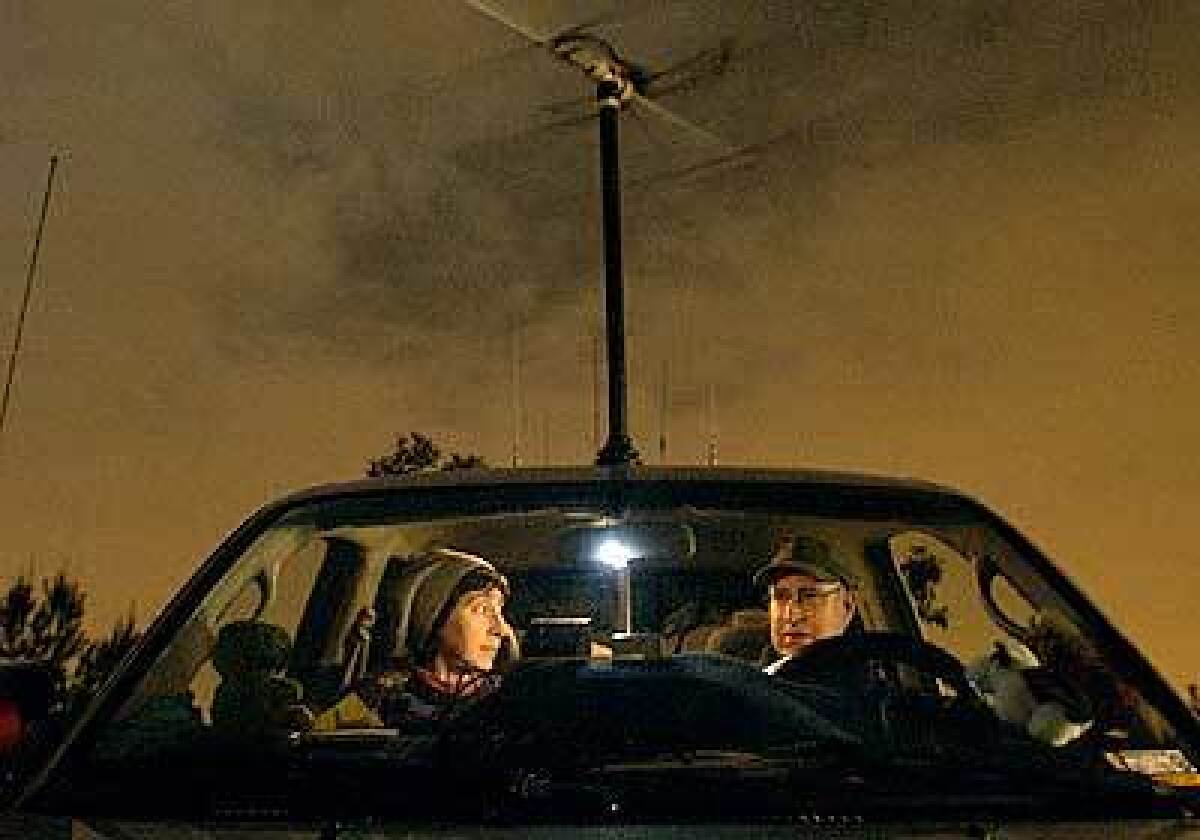Signal stalkers

Rushing toward the brushy hills of Griffith Park, J. Scott Bovitz grasps his favorite hunting weapon — a 4-foot “sniffer” antenna. An electronic transceiver and other gadgets dangle from his belt as he power-walks up a paved road from a picnic area, quickly cuts onto an equestrian trail then picks a path through the chaparral.
Bovitz is racing against the clock and more than a dozen competitors to corner the “foxes,” tiny transmitters hidden in the park that spew out signals for a few seconds at staggered intervals. His hand-held antenna acts as an electronic hound, sniffing out the telltale beeps. He stops every few minutes to take a reading, using both the sniffer antenna and the transceiver.
Slowly turning 360 degrees, the slender 6-foot-1 bankruptcy lawyer takes several readings as he tries to lock on the foxes’ faint signals. The park’s hilly terrain makes for “all bounces, all the time,” Bovitz says, straining to pick up a signal. “It is prime T-hunt country.” T-hunt, as in transmitter hunt.
Bovitz, 48, and other ham radio nuts obsessively chase transmitters on foot and by car in a bloodless quest he calls electronic hide and seek.
These hunter geeks know one another by call sign as readily as by name. They get their kicks chasing signals on foot through forested mountains or by car on remote dirt roads in the dead of night with rooftop antennas spinning. All this to bag electronic prey.Bovitz, whose call sign is N6MI or “November, Six, Mexico, Italy,” got his amateur radio license in 1969 and started hunting transmitters three years later.Good T-hunters are familiar with local geography and can think on the fly. Gut instinct comes in handy too, especially when it comes to the competition. You never know if opponents are telling the truth when they share information about possible leads to location of the foxes.
T-hunters, who sometimes go out in teams, develop an intimate knowledge of the quirks of their own equipment and have a deep affection for and curiosity about all things electronic. Many cobble together sniffer antennas from 30- to 36-inch sections of thin metal measuring tape — to act as antenna arms — attached to a metal or wooden frame. Much of the equipment is improvised or jury-rigged: A dime is as good as a screwdriver for tightening fittings at the last minute.
During the Griffith Park hunt on a sunny January weekend, there’s a lot more slogging up and down hills than standing still. The start-finish line is in the hills near the Mineral Wells Picnic Area. Husband and wife team Joe (K-Zero-OV) and April (WA6OPS) Moell share organizing duties, which include hiding the transmitters.
On a picnic table, they arrange a stack of numbered bibs, maps, water, soft drinks and chocolate to be used as pick-me-ups by finishers. Their mascot: a 12-inch-tall stuffed animal named “R.D. Fox” (for Radio Direction Finding).
On this hunt, it takes Bovitz two hours to find just one of the five hidden foxes. Jay Hennigan, 52, of the Santa Barbara Amateur Radio Club found all five in one hour and 39 minutes. Hennigan, who has the build of a cross-country runner, won the 2003 USA Amateur Radio Direction Finding Championship. Winners of national competitions advance to world championships, which started in the Soviet Union in 1980.
T-hunting by car means covering a lot more turf. Hams often tear through high mountains or dusty deserts, over rocky plateaus, into muddy creek beds. Sometimes they confront blocked or skewed signals because of metal signs, gasoline pumps or even the mountains. A phenomenon known as the Baldy Bounce, named after Mt. Baldy, confounds T-hunters all over Southern California.
On a recent Saturday night, Bovitz steers his pickup truck — tricked out with an antenna where the sunroof should be — to a Coyote Hills neighborhood in Fullerton.
The foxes have been hidden somewhere in a three-county area and are rigged with timers set to broadcast on a prearranged frequency. The hilltop start point allows the hams to begin to home in on the signals.
Bovitz drives north to the Puente Hills, as far west as the San Gabriel River, back east beyond Pomona and Ontario, then south on a small country road nearly to Corona. He presses a first-timer into service to “navi-guess,” trying to zero in on the transmitter by tracking readings on a map.
Early on Bovitz takes a couple of bearings in different locations: first near the entrance to Chino Hills Regional Park and a few minutes later the 57 Freeway. He drives a meandering, looping, zigzag course across all three counties. Another hunter about 20 miles away has broadcast that there are “strong signals,” but Bovitz is skeptical; it’s likely disinformation.
In the end, he snags the prey. Bovitz is the first to find two hidden transmitters along a gully near the San Gabriel River. Meet official Steve Heinemann (N6XFC) officiates from a lawn chair while watching a “Harry Potter” DVD on a laptop computer. His role is to keep an eye on the very large and expensive transmitter atop a tripod nearby but not to help hunters find a tiny one taped to the branch of a bush 50 yards away.
This hunt was a short one — around five hours, a cakewalk compared with some of the 48- or 72-hour hunts that can end up in Northern California, Arizona, Nevada, even Utah. As he heads onto the freeway at midnight to head for home, Bovitz admits eating and sleeping often take a back seat when he’s obsessing about a hunt.
“It is an addiction,” he says. “But at least it’s not drugs.”
*
For more information about transmitter hunting, go to www .arrl.org and https://www.homingin.com .
Steve Tice is a freelance writer based in Pasadena.